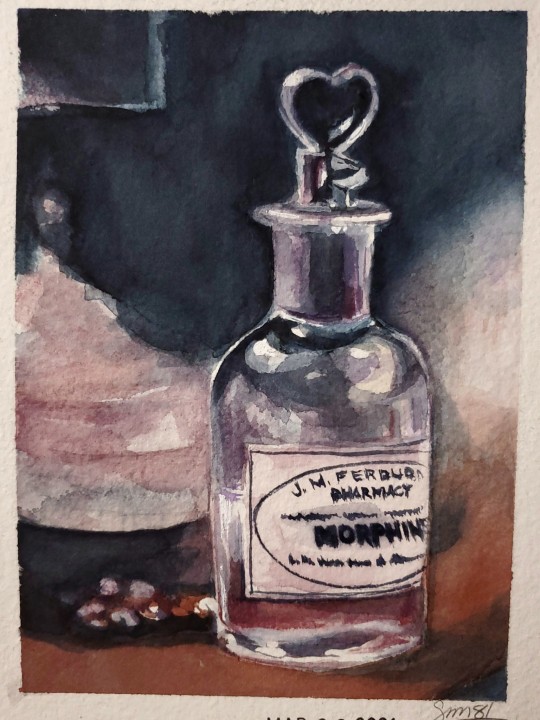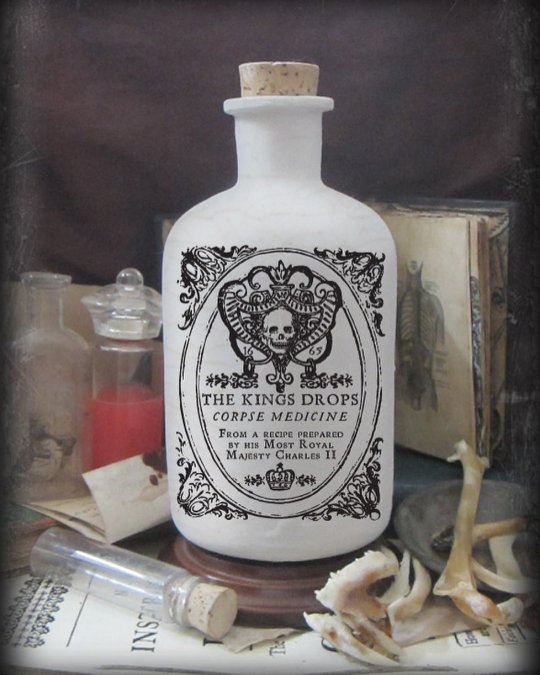#historicalmedicine
Video
Bottle order just finished and ready to be mailed. Get your own macabre medicine history at: www.ofgraveconcern.com/apothecarybottlesandjars Follow @ofgrave.concern for more dark history #medicinebottle #gothicstyle #gothicart #medicalhistory #historicalillustration #bottleart #bottleartwork #macabre #macabreart #macabreartist #poisonbottle #poisonbottles #corpsemedicine #medicinehistory #apothecary #apothecarycabinet #apothecaryart #apothecaryjars #historicalmedicine #folkmedicine #folkmedicinerevival #medicinecabinet #gothicvictorian #folkremedy #gothicillustration #ceramicsofinstagram #laudanum https://www.instagram.com/p/CTCy9LxHgNT/?utm_medium=tumblr
#medicinebottle#gothicstyle#gothicart#medicalhistory#historicalillustration#bottleart#bottleartwork#macabre#macabreart#macabreartist#poisonbottle#poisonbottles#corpsemedicine#medicinehistory#apothecary#apothecarycabinet#apothecaryart#apothecaryjars#historicalmedicine#folkmedicine#folkmedicinerevival#medicinecabinet#gothicvictorian#folkremedy#gothicillustration#ceramicsofinstagram#laudanum
2 notes
·
View notes
Text
Riddle Me This: What’s In My Medication?
By: Lisa Timmerman, Executive Director
In late 1860 and early 1861, Mrs. Mary F. Shacklett shopped with local shopkeepers Merchant & Claggett. Besides for neck handkerchiefs, cotton, buttons, knitting needles, shoes, and stockings, Mrs. Shacklett also purchased “1 Vial Virmafuge”. Although the merchants did not list the specific company associated with this medication, this little vial still contained a surprising amount of information from parasites to fraudsters.
Vermifuge has an interesting and squeamish history in Virginia as people purchased this product to treat parasitic worms. While doctors made significant strides in medicine during the Civil War, society already had enough understanding of parasites for people to market supposed cures. By the 1700s, Scientist Carolus Linnaeus identified, described, and named six helminth worms, and today we are sitting around an uncomfortable 300 species. Records of these infections certainly predate the 1700s with fascinating texts from Egypt (3000-400 B.C.) and China (3000-300 B.C.), suggesting these culprits were already causing havoc in human history. While the vermifuge business seemingly boomed after the Civil War with more apothecaries mixing and carrying the product, Mrs. Shacklett did have a few options on the market. B.A. Fahnestock & Company sold both white lead and a variety of patent medicines (in two separate companies), while Dr. David Jayne established one of the largest patent medicine firms with the name “Dr. D. Jayne and Son”. Fahnestock’s vermifuge mixture contained castor oils, oils of worm-seed, turpentine, and tincture of myrrh. Dr. Jayne launched an impressive marketing campaign by publishing medical annual almanacs, advertising all his products. For his vermifuge tonic, he notably scared parents by writing, “Parents are frequently deluded into the belief that their carefully nurtured child cannot possibly be suffering from worms, thinking that this infection can only be present in neglected children. This belief is not well founded, as all children are more or less exposed at times to worm infection.”

While both companies promised and guaranteed satisfaction and wormless children, patent medicine was a very lucrative field and growing steadily by the 1860s. British American colonists initially relied on imported British patented medicine and U.S. manufactures quickly started producing medicine after the Revolutionary War, selling their goods to apothecaries and hospitals. Due to a variety of factors, such as mass production, industrialization, and better marketing, the field boomed entering its’ “Golden Age” in the late 19th century. Prior to the Civil War, people generally viewed the peddlers selling directly to the public as deceptive scammers, but this changed as the companies greatly enhanced and improved their image through targeted advertising and marketing. Following the Civil War, people viewed patent medicines as less expensive accessible alternatives that the consumer could purchase directly (physicians started prescribing drugs in the mid-late 19th century). However, the term “patent” was very misleading as there was no government regulation or oversight of this industry. The medication could contain everything from water (most common) to morphine, so relief from these treatments varied greatly and certainly the placebo effect was in play (except for those with morphine). The companies could voluntarily opt to follow the American Medical Association Code of Ethics, which directed vendors to sell to physicians rather than the public, but the keyword here is voluntary. Advertisers exploited both women and minorities for sales, whether by labeling a product as “exotic” or from American Indian “medicine men”. While the companies targeted white middle-class populations (with racist and sexist marketing campaigns), many black communities purchased the products as black practitioners were uncommon and overwhelmed. By the early 20th century, patent medicines underwent a sharp decline as journalists, the medical community, and federal government targeted this often corrupt and unethical field.

Mrs. Shacklett’s ledger received special interest as Richard B. Merchant went to court to collect dues from her estate in 1870. The surviving member of Merchant & Claggett, he eventually received $17.84 from her estate in 1871. While we do not know the attended recipient of the purchased medication, we can assume they at least could tell if it worked or not as noticeably failing to kill parasitic worms would be…well noticeable. And disappointing.
Note: Our Children’s Day at the Museum Sponsored by Colonial Downs Group is one week early! We are celebrating African American folklore on Saturday, 02/12, at 10:00am, so as not to interfere with the Town of Dumfries Black History celebration. You can find tickets to our free virtual event here and info about the Town of Dumfries here.
(Sources: HDVI Archives; Cox, F E G. “History of human parasitology.” Clinical microbiology reviews vol. 15,4 (2002): 595-612. doi:10.1128/CMR.15.4.595-612.2002; Jayne Building Engraving, Finding Aids: Archival Collections at Hagley Museum & Library, https://findingaids.hagley.org/repositories/2/resources/424; Yates, Donald. Dr. Jayne’s Root Beer & Alternative. The Federation of Historical Bottle Collectors Magazine, Bottles and Extras, Winter 2005, Pages 28-29; Lockhart, Bill, Beau Schriever, Bill Lindsey, and Carol Serr, etc., The Fahnestock Companies, Society for Historical Archaeology, https://sha.org/bottle/pdffiles/Fahnestock.pdf; Chase, Matthew. Curses and Cures: A History of Pharmaceutical Advertising in America. University of St. Augustine for Health Sciences Library, https://library.usa.edu/cures-curses-exhibit#:~:text=Patent%20medicines%20in%20the%20United,demand%20among%20apothecaries%20and%20hospital, part of the Public Library Association’s Project Outcome)
#archives#medicine#historicalmedicine#patentmedicine#falseadvertising#localhistory#americanhistory#buyerbeware#parasites#merchants#shopping#shopkeepers#courtrecords
0 notes
Text

Color study: Morphine- just a color Study for a larger peice I want to work on. I think the first time I have painted a glass bottle. It was very fun. This is from my peakyblinders series.
#watercolor #peakyblinders #antique #oldpharmacy #historicalmedicine #tommyshelby
13 notes
·
View notes
Photo

27th September 1822 French scholar, philologist, orientalist, and one for the founders of the field of Egyptology, Jean-Francois Champollion announces he has deciphered Egyptian hieroglyphics using the Rosetta Stone. A child prodigy at language and its study, Champollion spoke fluent Coptic and Arabic, and had begun to decipher the Egyptian Demotic script at the age of 16. Champollion came of age during the craze of Egyptomania', the late 18th and 19th century explosion of popular interest in the ancient culture of Egypt. Its origins lay in Napoleon's Egyptian Campaign (1798–1801), which while mostly military also sent artists, scientists, and antiquitarians to discover the ancient temples, buildings and culture. Through its discoveries, an aesthetic impact on literature, art and architecture took place, including an antiquarian battle to secure the best discoveries. During the invasion the ‘Institut d’Égypte’ was established by Napoleon and the 167 enlightenment scientists and scholars who accompanied the invasion. The scholars' research in Egypt gave rise to the ‘Description de l'Égypte’, published between 1809 and 1821. The work was a comprehensive scientific description of ancient and modern Egypt, as well as its natural history. They also discovered in 1799 the Rosetta Stone, an ancient stone marker displaying hieroglyphics, demotic and Ancient Greek. The stone was later captured by the British, but it was Champollion who was the first to decipher the hieroglyphics on this day. The Egyptomania of the late 18th and 19th centuries is featured in the historically inspired Ofgraveconcern Industrial Sublime Tarot 1760 - 1848. Prints of the cards as shown as well as the entire deck are for sale on the website see link in bio. Also for sale is a reproduction of mummy powder the historical cure all, and 19th century reproductions of advertisements as shown for egyptian mummy unwrapping parties, and exhibitions. See link in bio for all art shown. #rosettastone #egyptomania #jeanfrançoischampollion #ozymandius #egypt #egyptianart #egyptianmythology #mummies #tarot #tarotart #tarotartist #historicalmedicine #egyptianmummies #napoleonbonaparte #historyart #history https://www.instagram.com/p/CFpDRu2gEWh/?igshid=xvhloet7pwd4
#rosettastone#egyptomania#jeanfrançoischampollion#ozymandius#egypt#egyptianart#egyptianmythology#mummies#tarot#tarotart#tarotartist#historicalmedicine#egyptianmummies#napoleonbonaparte#historyart#history
1 note
·
View note
Photo

The Tale of Titus Oates 15th September 1649, birth of English minister and plotter Titus Oates, instigator of the fabricated ‘Popish Plot’, which imagined a catholic plot to assassinate Charles II, and bring down the government. Oates' plot resulted in anti catholic hysteria in England and Scotland, and the false accusation and execution of at least fifteen people including the hanging, drawing and quartering of the Catholic Archbishop of Armagh Oliver Plunkett, the last Catholic martyr to die in England. Those accused by Oates’, were tried by the infamous Baron George Jeffreys, known to history as the ‘hanging judge’, for his role in the ‘Bloody Assizes’ of 1685. After accusing the diarist Samuel Pepys, and then in 1678 the Queen alongside the King’s physician, of attempting to poison Charles II, public opinion began to turn against Oates. With the death of Charles II in 1685, Oates was arrested upon the orders of Charles’ brother James II, and further ordered to be "whipped through the streets of London five days a year for the remainder of his life." During his first whipping he was forced to wear a hat which read, "Titus Oates, convicted upon full evidence of two horrid perjuries". Oates’ arrest and conviction had been presided over by the ‘Hanging Judge’ himself, George Jeffreys, who ironically despite having sentenced those falsely accused by Oates to execution, declared Oates a "shame to mankind". Even the ‘Hanging Judge’ though did not escape the turbulent times, three years later Jeffrey’s himself was captured trying to flee London disguised as a sailor, after James II was deposed during the ‘Glorious Revolution’ of 1688. Continued in the comments section, #17thcentury #execution #historicalmedicine #macabre #macabreart #macabreartist #charlesii #macabrehistory #hangingjudgejeffries #medicinebottles #dark #toweroflondon #unique #interestingfacts #interestingart #corpsemedicine #gloriousrevolution #history #historyfacts #historylovers #historic #historical #reproduction #medicalhistory #hiddenhistory #antiquebottles #dark #darkhistory https://www.instagram.com/p/CFXBhqhAPxz/?igshid=fmleaujtm7jw
#17thcentury#execution#historicalmedicine#macabre#macabreart#macabreartist#charlesii#macabrehistory#hangingjudgejeffries#medicinebottles#dark#toweroflondon#unique#interestingfacts#interestingart#corpsemedicine#gloriousrevolution#history#historyfacts#historylovers#historic#historical#reproduction#medicalhistory#hiddenhistory#antiquebottles#darkhistory
0 notes
Photo

21st January 1677, publication of the first medical pamphlet in North America, published in Boston: ’A brief rule to guide the common people of New-England how to order themselves and theirs in the small pocks, or measels.’ written by Thomas Thacher, appeared on this day during the smallpox epidemic of that year. Boston in 1677 had only been established for 37 years; however smallpox had already become established in Native American populations, who had had no previous contact with the disease, it would kill an estimated 90 percent of North America’s Native peoples, before the end of the 17th century. Even in populations where it was established, smallpox would continue to kill an estimated 400,000 people a year in 18th Century Europe alone. Again in Boston in 1721, the Reverend Cotton Mather, best known for his involvement in the Salem witch trials, would provoke controversy by pushing for a treatment told to him by his African slave Onesimus, who had been inoculated in Africa as a boy. On June 6, 1721, Mather sent reports on inoculation to local physicians, most viewing inoculation as violating the natural laws of medicine. However Boston doctor, and great uncle of future President John Adams, Dr. Zabdiel Boylston, did successfully try the procedure on his youngest son and two slaves. In 1798 a smallpox vaccination was successfully demonstrated and proved to be effective by Dr. Edward Jenner, leading to smallpox’s global eradication in 1980. All art shown is influenced by the history of medicine and mortality. You can find all the art plus lots more at the website: www.ofgraveconcern.com/medicineandmortality For More dark art and history follow @ofgrave.concern #thisweekinhistory #gothichistory #medicalhistory #historyofmedicine #smallpox #newenglandhistory #medicalpost #nativeamericans #historyofdisease #epidemic #epidemics #innoculation #ᴠᴀᴄᴄɪɴᴇssᴀᴠᴇʟɪᴠᴇs #vaccination #bostonhistory #cottonmather #medicinemaking #edwardjenner #17thcentury #18thcentury #tarotart #tarotillustration #medicinebottle #medicinebottles #ceramicbottle #ceramicartist #medicineart #medicalart #historicalmedicine #smallpoxhospital https://www.instagram.com/p/CZFF286FMna/?utm_medium=tumblr
#thisweekinhistory#gothichistory#medicalhistory#historyofmedicine#smallpox#newenglandhistory#medicalpost#nativeamericans#historyofdisease#epidemic#epidemics#innoculation#ᴠᴀᴄᴄɪɴᴇssᴀᴠᴇʟɪᴠᴇs#vaccination#bostonhistory#cottonmather#medicinemaking#edwardjenner#17thcentury#18thcentury#tarotart#tarotillustration#medicinebottle#medicinebottles#ceramicbottle#ceramicartist#medicineart#medicalart#historicalmedicine#smallpoxhospital
0 notes